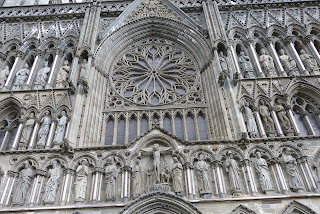Saturday 2nd June
 Today we planned to visit the
Nidaros Cathedral the principal church and Norway’s National Shrine. Work on the building started in 1070 and it
was originally a small church which grew and when it was completed in in the 1300s
was recognised as a cathedral. In 1152
it was established as the seat of the Roman Catholic Archbishop until the
Reformation in 1537 when it became the cathedral of the Lutheran Bishop of
Trondheim.
Today we planned to visit the
Nidaros Cathedral the principal church and Norway’s National Shrine. Work on the building started in 1070 and it
was originally a small church which grew and when it was completed in in the 1300s
was recognised as a cathedral. In 1152
it was established as the seat of the Roman Catholic Archbishop until the
Reformation in 1537 when it became the cathedral of the Lutheran Bishop of
Trondheim. In the 13, 15 and 1700s the
church was badly damaged by fires and the nave west of the transept wasn’t
rebuilt until the 1900s after the major restoration work commenced in 1869. The stained glass windows which are installed
on two levels and were made during the restoration work in the 19th
and 20th centuries, the Rose window in the west has over 10,000
pieces.
In the 13, 15 and 1700s the
church was badly damaged by fires and the nave west of the transept wasn’t
rebuilt until the 1900s after the major restoration work commenced in 1869. The stained glass windows which are installed
on two levels and were made during the restoration work in the 19th
and 20th centuries, the Rose window in the west has over 10,000
pieces.
The present cathedral has two
principal altars, the one in the east
end of the chancel rests on the site of the medieval high altar which bore the
silver reliquary casket containing the remains of St Olav the church's and the
kingdom's patron saint, until a king in the middle ages moved it.
The church has been the
traditional place of coronation of the Kings of Norway but the last two kings
have elected to have a benediction instead of a crowning.
 When we arrived we decided to
climb the 172 narrow winding steps to the tower for a view over Trondheim also
the roof and tops of the walls and buttresses of the cathedral which are
decorated with heads and other mythical creatures, the workmanship of the
restoration’s craftsmen was equal to their predecessors.
When we arrived we decided to
climb the 172 narrow winding steps to the tower for a view over Trondheim also
the roof and tops of the walls and buttresses of the cathedral which are
decorated with heads and other mythical creatures, the workmanship of the
restoration’s craftsmen was equal to their predecessors.
Two organs are installed in the
Cathedral. The main organ was built by the Steinmeyer firm in 1930, and was
erected in the north transept. It then had 125 stops and in 1962 it was rebuilt
and moved to the west nave. The guide
book now states it has 127 registers and 9600 pipes, many of the pipes are
installed on the balconies along the nave which provides “surround sound”.
We returned to the cathedral at
1:30 for prayers and the organ recital, at times the music came from the pipes
in organ loft in the west and then from the east and then all around us.
Our next visit was to the
Archbishop’s Palace museum which contains many of the sculptures removed from
the damaged cathedral. Over the years
the palace, like the cathedral has been damaged by fire and during excavations
the Archbishop’s mint was discovered, some early Archbishops received the
authority from the king to mint and distribute coins. Also many artefact have been recovered which have
provided an insight to life in the palace through the centuries.
From the Archbishop’s museum we
went to the regalia museum, this contains an interesting history and details of
the kings of Norway from Olav Tryggvason who founded the city in 997 through to
the present day king. In the cellar
(crypt) the Royal Regalia of Norway including crown jewels is displayed and includes,
the king's crown, the sword of the realm, the king's sceptre, the king's orb,
the queen's crown, the queen's sceptre, the queen's orb, the crown of the crown
prince and the anointing horn. Also in this collection are several coronation
robes, two banners of the realm and coronation thrones.
 The king’s crown jewels were made
for the coronation of King Carl Johan in 1818, the king also paid for them and
the queen’s regalia was acquired in 1830.
The king’s crown jewels were made
for the coronation of King Carl Johan in 1818, the king also paid for them and
the queen’s regalia was acquired in 1830.
When we were on the cathedral
tower we could see Kristiansten Fortress high on a hill and decided to walk up
the hill to visit it. We soon found out
why it had never been captured, any army trying to attack up the hill would
have been exhausted by the time they reached the top. The fortress was built in 1681 and saved the
city from conquest by Sweden in 1718. During
the German occupation it was used as a place of execution for members of the
Norwegian Resistance.
Today was the first day the
fortress was open for the summer season and we were treated to a display of
marching with drum and fife, musket volleys and other people dressed in period
army uniforms. They were camped in the
grounds, together with their families, who were also dressed in period costume.
On our way back to the hotel, in
a pedestrian mall we encountered a male choir singing popular songs, one “When
the Saints” they sang part of it using the “Alleluia Chorus” as the melody, an interesting
adaption.

No comments:
Post a Comment